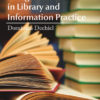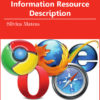RFID (Radio Frequency Identification) allows an item, for example a library book, to be tracked and communicated with by radio waves. This technology is similar in concept to a cellphone. RFID is a broad term for technologies that use radio waves to automatically identify people or objects. There are several methods of identification, but the most common is to store a serial number that identifies a person or object, and perhaps other information, on a microchip that is attached to an antenna (the chip and the antenna together are called an RFID transponder or an RFID tag). The antenna enables the chip to transmit the identification information to a reader. The reader converts the radio waves reflected back from the RFID tag into digital information that can then be passed on to computers that can make use of it. RFID can be used library circulation operations and theft detection systems. RFID-based systems move beyond security to become tracking systems that combine security with more efficient tracking of materials throughout the library, including easier and faster charge and discharge, inventorying, and materials handling. This technology helps librarians reduce valuable staff time spent scanning barcodes while charging and discharging items.
RFID is a combination of radio -frequency-based technology and microchip technology. Libraries should be exploring mobile devices as a way to connect with patrons. Creating a library application or mobile Web site that allows patrons to access library hours, view their library account or even search databases is easier than most people think. The book entitled Exploring the Potential of RFID and Mobile Technology in Your Library emphasizes an overview of RFID technology in libraries; advice on how to select an RFID solution, from choosing between suppliers and evaluating the competition to; designing your own solution and making the right business case; strategies for ensuring a smooth installation; case studies of RFID and technology use and a look at the future of RFID, including mobile technology and other uses beyond books. This book will be important reading for anyone with responsibility for integrating library systems, those with responsibility for selection, evaluation or procurement of IT solutions and responsibility for service development, managing collections or managing access to buildings. It will also be of interest to commercial companies, who are seeking insights into library working in order to introduce new products, and LIS students.













